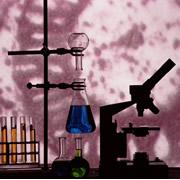 Have toxicology tests lagged behind in the development of green solvents?© Photodisk
Have toxicology tests lagged behind in the development of green solvents?© PhotodiskResearchers are cautioning that a group of chemical compounds touted as 'green' might not be so green after all.
Ionic liquids are often said to be an environmentally sound alternative to conventional solvents. But a team of Italian researchers has found that some of these liquids are highly toxic to fish.
Many industrial chemical processes rely on organic solvents to dissolve the molecules that are knitted together to make drugs, fungicides and a host of other useful compounds. But conventional organic solvents, such as methanol or acetonitrile, tend to evaporate easily, making them difficult to work with. Not only can they escape into the atmosphere, affecting the environment and human health, they are also highly flammable.
Over the last decade, chemists have invented a range of ionic compounds that are liquids around room temperature and are good at dissolving useful chemicals. Furthermore, these compounds have a very low vapour pressure and are non-flammable.
However, a team of scientists led by Cinzia Chiappe from the University of Pisa, Italy, points out that very little is known about the toxicity of these liquids. So the researchers tested the effects of a range of ionic liquids on zebrafish (Danio rerio). They found that even low exposures of particular types of solvents could damage their gills.
Solvents are not meant to escape from the lab. But when used on an industrial scale, it is possible that small quantities could leak into waterways, says Chiappe. So it is important to carry out more toxicology tests on ionic liquids to find out which are truly benign to the environment, she adds. "Many compounds will be toxic, but plenty of others will not," she predicts.
It's not easy being green
To perform the tests, ten fish were put in a glass aquarium filled with water containing traces of the ionic liquid. The fish were observed for four days. The scientists found that a family of ammonium salts carrying long carbon chains were particularly toxic to the fish. Thankfully, points out Chiappe, these are not at present widely used.
The team reports that less than six milligrams of each compound per litre of the fishes' water was enough to kill half of them. This concentration is much lower than it takes for conventional solvents to kill fish. When the fish were dissected, the scientists found that parts of their gills had swollen, potentially giving the fish breathing problems.
This is the first time that toxicity tests on ionic liquids have been done using such large organisms, says Nick Gathergood, a chemist at Dublin City University, Ireland. He has previously investigated the effects of ionic liquids using water fleas (Daphnia magna).
Toxicology has definitely lagged behind in the development of ionic liquids, says Gathergood. "It's only recently that people have started to look at their toxicity," he adds. "Previously, people had assumed they were going to be okay."
The long road
ADVERTISEMENT
Gathergood says that the Italian research backs up his own finding that ionic liquids whose molecules contain longer carbon chains seem to be more toxic.
Such long-chained units are often used for helping to fine-tune ionic liquids to specific processes. "I really feel that with longer chains you're getting into a grey area [for toxicity]," he says. "This has implications for making task-specific ionic liquids."
The Italian team are now studying other ionic liquids to look for trends in toxicity that might relate to particular chemical groups.
